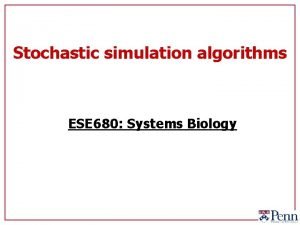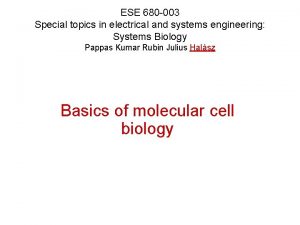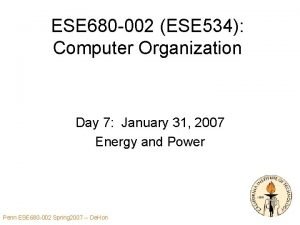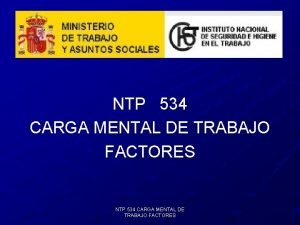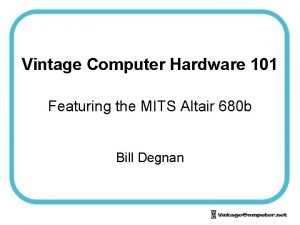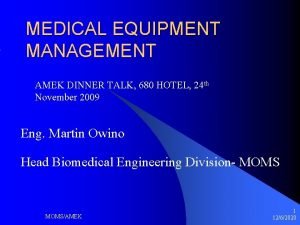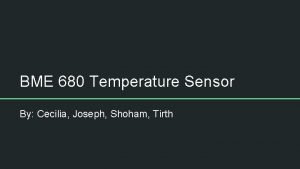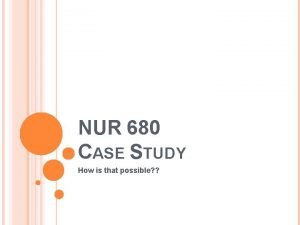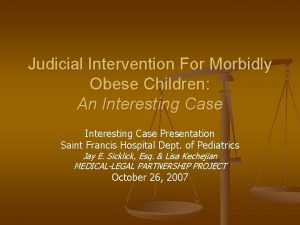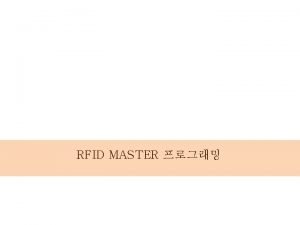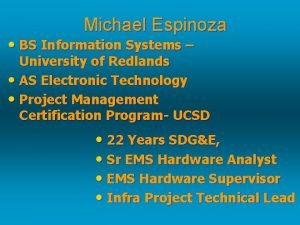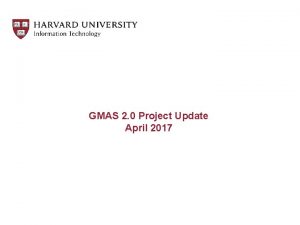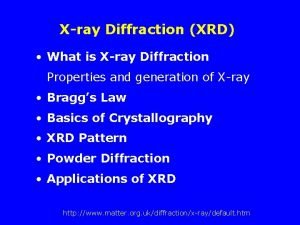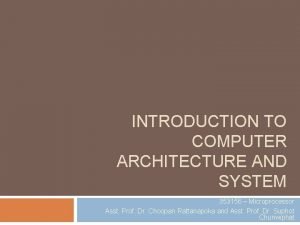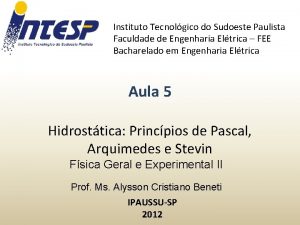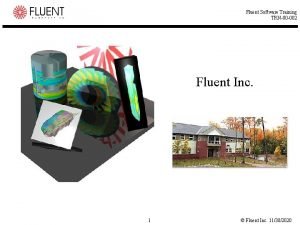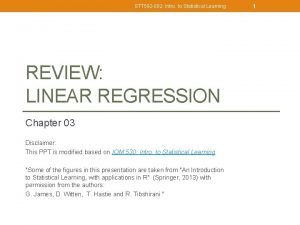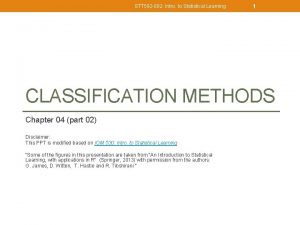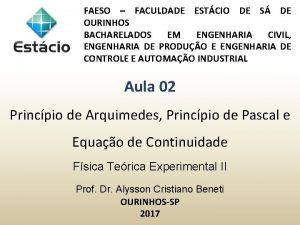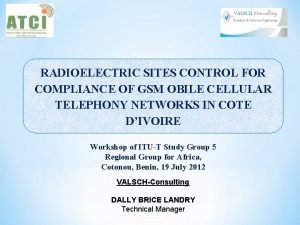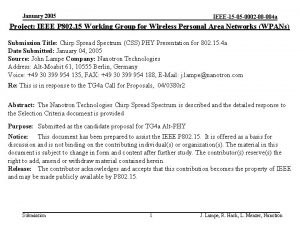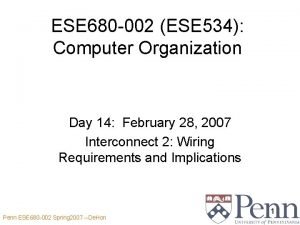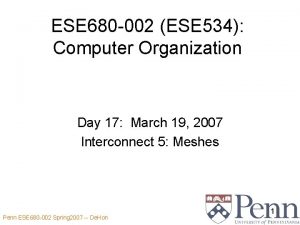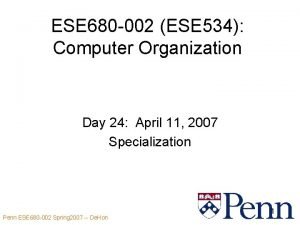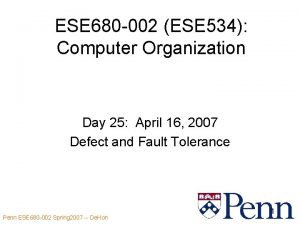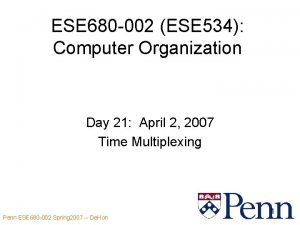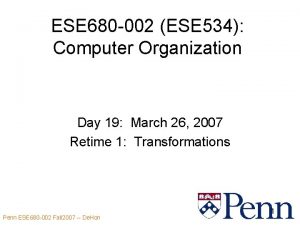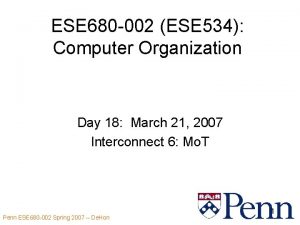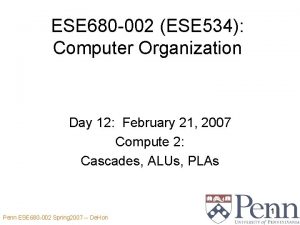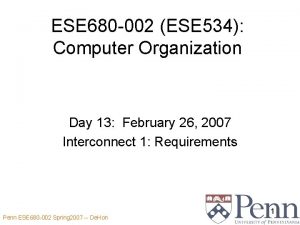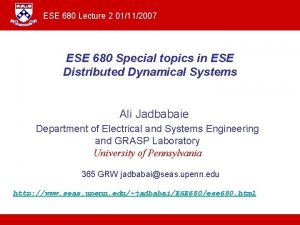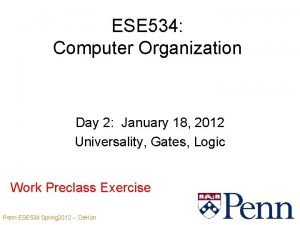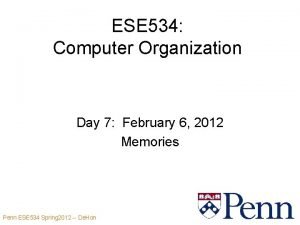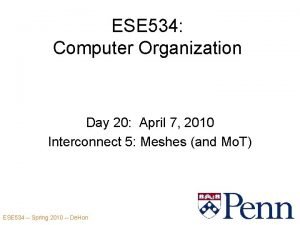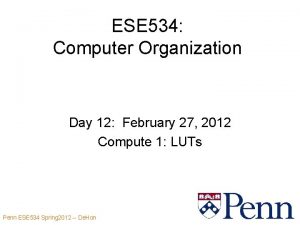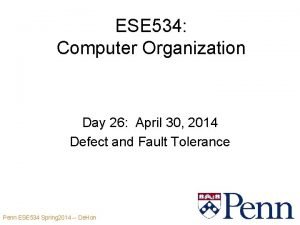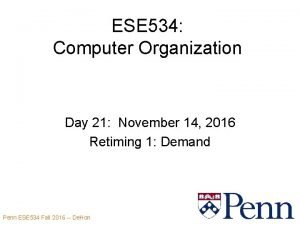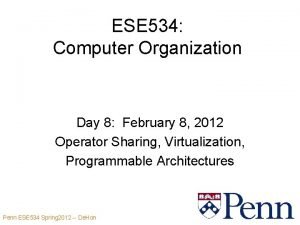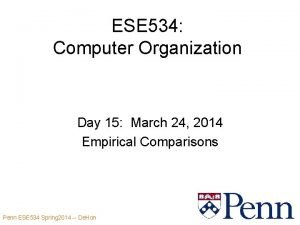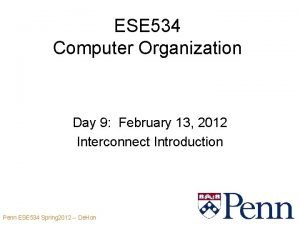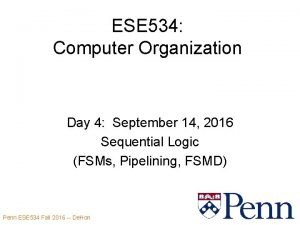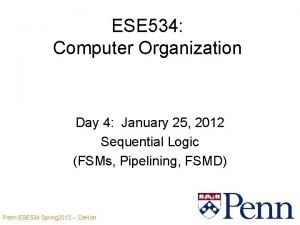ESE 680 002 ESE 534 Computer Organization Day

















































![Big Ideas [MSB Ideas] • Memory: efficient way to hold state – …and allows Big Ideas [MSB Ideas] • Memory: efficient way to hold state – …and allows](https://slidetodoc.com/presentation_image_h2/8fb46eab50c0334671d11eba6e1ba0c2/image-50.jpg)
![Big Ideas [MSB-1 Ideas] • ALUs and LUTs as universal compute elements • First Big Ideas [MSB-1 Ideas] • ALUs and LUTs as universal compute elements • First](https://slidetodoc.com/presentation_image_h2/8fb46eab50c0334671d11eba6e1ba0c2/image-51.jpg)
- Slides: 51

ESE 680 -002 (ESE 534): Computer Organization Day 5: January 24, 2007 ALUs, Virtualization… Penn ESE 680 -002 Spring 2007 -- De. Hon 1

Last Time • Memory • Memories pack state compactly – densely Penn ESE 680 -002 Spring 2007 -- De. Hon 2

Day 4 What is Importance of Memory? • Radical Hypothesis: – Memory is simply a very efficient organization which allows us to store data compactly • (at least, in the technologies we’ve seen to date) – A great engineering trick to optimize resources • Alternative: – memory is a primary Penn ESE 680 -002 Spring 2007 -- De. Hon 3

Today • • ALUs Virtualization Datapath Operation Memory – …continue unpacking the role of memory… Penn ESE 680 -002 Spring 2007 -- De. Hon 4

Last Wednesday • Given a task: y=Ax 2 +Bx +C • Saw how to share primitive operators • Got down to one of each Penn ESE 680 -002 Spring 2007 -- De. Hon 5

Very naively • Might seem we need one of each different type of operator Penn ESE 680 -002 Spring 2007 -- De. Hon 6

. . But • Doesn’t fool us • We already know that nand gate (and many other things) are universal • So, we know, we can build a universal compute operator Penn ESE 680 -002 Spring 2007 -- De. Hon 7

This Example • y=Ax 2 +Bx +C • Know a single adder will do Penn ESE 680 -002 Spring 2007 -- De. Hon 8

Is an Adder Universal? • Assuming interconnect: – (big assumption as we’ll see later) – Consider: A: 001 a B: 000 b S: 00 cd • What’s c? Penn ESE 680 -002 Spring 2007 -- De. Hon 9

Practically • To reduce (some) interconnect • and to reduce number of operations • do tend to build a bit more general “universal” computing function Penn ESE 680 -002 Spring 2007 -- De. Hon 10

Arithmetic Logic Unit (ALU) • Observe: – with small tweaks can get many functions with basic adder components Penn ESE 680 -002 Spring 2007 -- De. Hon 11

Arithmetic and Logic Unit Penn ESE 680 -002 Spring 2007 -- De. Hon 12

ALU Functions • A+B w/ Carry • B-A • A xor B (squash carry) • A*B (squash carry) • /A • B<<1 Penn ESE 680 -002 Spring 2007 -- De. Hon 13

Table Lookup Function • Observe 2: only inputs 3 2 2 =256 functions of 3 – 3 -inputs = A, B, carry in from lower • Two, 3 -input Lookup Tables – give all functions of 2 -inputs and a cascade – 8 b to specify function of each lookup table • LUT = Look. Up Table Penn ESE 680 -002 Spring 2007 -- De. Hon 14

What does this mean? • With only one active component – ALU, nand gate, LUT • Can implement any function – given appropriate • state registers • muxes (interconnect) • Control Penn ESE 680 -002 Spring 2007 -- De. Hon 15

Defining Terms Fixed Function: • Computes one function (e. g. FPmultiply, divider, DCT) • Function defined at fabrication time Penn ESE 680 -002 Spring 2007 -- De. Hon Programmable: • Computes “any” computable function (e. g. Processor, DSPs, FPGAs) • Function defined after fabrication 16

Revisit Example Can implement any function given appropriate • state registers • muxes (interconnect) • control • We do see a proliferation of memory and muxes -- what do we do about that? Penn ESE 680 -002 Spring 2007 -- De. Hon 17

Virtualization Penn ESE 680 -002 Spring 2007 -- De. Hon 18

Back to Memories • State in memory more compact than “live” registers – shared input/output/drivers • If we’re sequentializing, only need one (few) data item at a time anyway – i. e. sharing compute unit, might as well share interconnect • Shared interconnect also gives muxing function Penn ESE 680 -002 Spring 2007 -- De. Hon 19

ALU + Memory Penn ESE 680 -002 Spring 2007 -- De. Hon 20

What’s left? Penn ESE 680 -002 Spring 2007 -- De. Hon 21

Control • Still need that controller which directed which state, went where, and when • Has more work now, – also say what operations for compute unit Penn ESE 680 -002 Spring 2007 -- De. Hon 22

Implementing Control • Implementing a single, fixed computation – might still just build a custom FSM Penn ESE 680 -002 Spring 2007 -- De. Hon 23

…and Programmable • At this point, it’s a small leap to say maybe the controller can be programmable as well • Then have a building block which can implement anything – within state and control programmability bounds Penn ESE 680 -002 Spring 2007 -- De. Hon 24

Simplest Programmable Control • Use a memory to “record” control instructions • “Play” control with sequence Penn ESE 680 -002 Spring 2007 -- De. Hon 25

Our “First” Programmable Architecture Penn ESE 680 -002 Spring 2007 -- De. Hon 26

Instructions • Identify the bits which control the function of our programmable device as: – Instructions Penn ESE 680 -002 Spring 2007 -- De. Hon 27

Programming an Operation • Consider: § C = (A+2 B) & 00001111 • Cannot do this all at once • But can do it in pieces Penn ESE 680 -002 Spring 2007 -- De. Hon 28

ALU Encoding • • Each operation has some bit sequence ADD 0000 SUB 0010 INV 0001 SLL 1110 SLR 1100 AND 1000 Penn ESE 680 -002 Spring 2007 -- De. Hon 29

Programming an Operation C = (A+2 B) & 00001111 Op • Decompose into pieces w src 1 src 2 dst • Compute 2 B 0000 1 001 010 • Add A and 2 B 0000 1 000 011 • AND sum with mask 1000 1 011 100 111 Penn ESE 680 -002 Spring 2007 -- De. Hon 30

Fill Instruction Memory Op w src 1 src 2 dst • 000: 0000 1 001 010 • 001: 0000 1 000 011 • 010: 1000 1 011 100 111 Program operation by filling memory. Penn ESE 680 -002 Spring 2007 -- De. Hon 31

Machine State: Initial • Counter: 0 • Instruction Memory: 0000 1 001 010 001: 0000 1 000 011 010: 1000 1 011 100 111 Penn ESE 680 -002 Spring 2007 -- De. Hon • Data Memory: 000: A 001: B 010: ? 011: ? 100: 00001111 101: ? 110: ? 111: ? 32

First Operation • Counter: 0 • Instruction Memory: 0000 1 001 010 001: 0000 1 000 011 010: 1000 1 011 100 111 Penn ESE 680 -002 Spring 2007 -- De. Hon • Data Memory: 000: A 001: B 010: ? 011: ? 100: 00001111 101: ? 110: ? 111: ? 33

First Operation Complete • Counter: 0 • Instruction Memory: 0000 1 001 010 001: 0000 1 000 011 010: 1000 1 011 100 111 Penn ESE 680 -002 Spring 2007 -- De. Hon • Data Memory: 000: A 001: B 010: 2 B 011: ? 100: 00001111 101: ? 110: ? 111: ? 34

Update Counter • Counter: 1 • Instruction Memory: 0000 1 001 010 001: 0000 1 000 011 010: 1000 1 011 100 111 Penn ESE 680 -002 Spring 2007 -- De. Hon • Data Memory: 000: A 001: B 010: 2 B 011: ? 100: 00001111 101: ? 110: ? 111: ? 35

Second Operation • Counter: 1 • Instruction Memory: 0000 1 001 010 001: 0000 1 000 011 010: 1000 1 011 100 111 Penn ESE 680 -002 Spring 2007 -- De. Hon • Data Memory: 000: A 001: B 010: 2 B 011: ? 100: 00001111 101: ? 110: ? 111: ? 36

Second Operation Complete • Counter: 1 • Instruction Memory: 0000 1 001 010 001: 0000 1 000 011 010: 1000 1 011 100 111 Penn ESE 680 -002 Spring 2007 -- De. Hon • Data Memory: 000: A 001: B 010: 2 B 011: A+2 B 100: 00001111 101: ? 110: ? 111: ? 37

Update Counter • Counter: 2 • Instruction Memory: 0000 1 001 010 001: 0000 1 000 011 010: 1000 1 011 100 111 Penn ESE 680 -002 Spring 2007 -- De. Hon • Data Memory: 000: A 001: B 010: 2 B 011: A+2 B 100: 00001111 101: ? 110: ? 111: ? 38

Third Operation • Counter: 2 • Instruction Memory: 0000 1 001 010 001: 0000 1 000 011 010: 1000 1 011 100 111 Penn ESE 680 -002 Spring 2007 -- De. Hon • Data Memory: 000: A 001: B 010: 2 B 011: A+2 B 100: 00001111 101: ? 110: ? 111: ? 39

Third Operation Complete • Counter: 2 • Instruction Memory: 0000 1 001 010 001: 0000 1 000 011 010: 1000 1 011 100 111 Penn ESE 680 -002 Spring 2007 -- De. Hon • Data Memory: 000: A 001: B 010: 2 B 011: A+2 B 100: 00001111 101: ? 110: ? 111: (A+2 B) & … 40

Result • Can sequence together primitive operations in time • Communicating state through memory – Memory as interconnect • To perform “arbitrary” operations Penn ESE 680 -002 Spring 2007 -- De. Hon 41

“Any” Computation? (Universality) • Any computation which can “fit” on the programmable substrate • Limitations: hold entire computation and intermediate data Penn ESE 680 -002 Spring 2007 -- De. Hon 42

What have we done? • Taken a computation: y=Ax 2 • Turned it into operators and interconnect +Bx +C • Decomposed operators into a basic primitive: Additions, ALU, . . . nand Penn ESE 680 -002 Spring 2007 -- De. Hon 43

What have we done? • Said we can implement it on as few as one of compute unit {ALU, LUT, nand} • Added a unit for state • Added an instruction to tell single, universal unit how to act as each operator in original graph Penn ESE 680 -002 Spring 2007 -- De. Hon 44

Virtualization • • • We’ve virtualized the computation No longer need one physical compute unit for each operator in original computation Can suffice with: 1. shared operator(s) 2. a description of how each operator behaved 3. a place to store the intermediate data between operators Penn ESE 680 -002 Spring 2007 -- De. Hon 45

Virtualization Penn ESE 680 -002 Spring 2007 -- De. Hon 46

Why Interesting? • Memory compactness • This works and was interesting because – the area to describe a computation, its interconnect, and its state – is much smaller than the physical area to spatially implement the computation • e. g. traded multiplier for – few memory slots to hold state – few memory slots to describe operation – time on a shared unit (ALU) Penn ESE 680 -002 Spring 2007 -- De. Hon 47

Questions? Penn ESE 680 -002 Spring 2007 -- De. Hon 48

Admin Comments • Homework #2 due Monday • Reading: Dennard on Scaling Penn ESE 680 -002 Spring 2007 -- De. Hon 49
![Big Ideas MSB Ideas Memory efficient way to hold state and allows Big Ideas [MSB Ideas] • Memory: efficient way to hold state – …and allows](https://slidetodoc.com/presentation_image_h2/8fb46eab50c0334671d11eba6e1ba0c2/image-50.jpg)
Big Ideas [MSB Ideas] • Memory: efficient way to hold state – …and allows us to describe/implement computations of unbounded size • • State can be << computation [area] Resource sharing: key trick to reduce area Memory key tool for Area-Time tradeoffs “configuration” signals allow us to generalize the utility of a computational operator Penn ESE 680 -002 Spring 2007 -- De. Hon 50
![Big Ideas MSB1 Ideas ALUs and LUTs as universal compute elements First Big Ideas [MSB-1 Ideas] • ALUs and LUTs as universal compute elements • First](https://slidetodoc.com/presentation_image_h2/8fb46eab50c0334671d11eba6e1ba0c2/image-51.jpg)
Big Ideas [MSB-1 Ideas] • ALUs and LUTs as universal compute elements • First programmable computing unit • Two key functions of memory – retiming (interconnect in time) – instructions • description of computation Penn ESE 680 -002 Spring 2007 -- De. Hon 51
 Ese 680
Ese 680 Ese 680
Ese 680 Ese 680
Ese 680 Day 1 day 2 day 3 day 4
Day 1 day 2 day 3 day 4 Ntp 534
Ntp 534 Day 1 day 2 day 817
Day 1 day 2 day 817 Process organization in computer organization
Process organization in computer organization Altair 680b
Altair 680b Talk 680
Talk 680 F tag 680
F tag 680 Bme 680
Bme 680 Nur 680
Nur 680 Christina corrigan
Christina corrigan 44 word form
44 word form A 680 newton student runs up a flight of stairs
A 680 newton student runs up a flight of stairs Basic structure of computer in computer organization
Basic structure of computer in computer organization Difference between computer architecture and organization
Difference between computer architecture and organization Design of basic computer
Design of basic computer Basic computer organisation and design
Basic computer organisation and design Mfc-002
Mfc-002 Norsok z-dp-002
Norsok z-dp-002 Semt.001
Semt.001 Puneeth iyengar
Puneeth iyengar Cip 002-009
Cip 002-009 Gmas-002
Gmas-002 Pyp 002
Pyp 002 001 002 003
001 002 003 002
002 002
002 002
002 353156
353156 Pressão hidrostática
Pressão hidrostática 002
002 Flowchart elevator
Flowchart elevator Um objeto com massa de 10kg e volume de 0 002
Um objeto com massa de 10kg e volume de 0 002 002
002 002
002 002
002 Semt.002
Semt.002 002
002 Um objeto com massa de 10kg e volume de 0 002
Um objeto com massa de 10kg e volume de 0 002 Dtu p 06-002
Dtu p 06-002 0,05/0,002
0,05/0,002 001 002 003
001 002 003 Block organization and point by point organization
Block organization and point by point organization Schoolmax gradebook
Schoolmax gradebook Oceans apart day after day meaning
Oceans apart day after day meaning Day to day maintenance
Day to day maintenance Physical science chapter 6 review answers
Physical science chapter 6 review answers Tomorrow i don't know
Tomorrow i don't know Romeo and juliet timeline review answer key
Romeo and juliet timeline review answer key Growing day by day
Growing day by day
